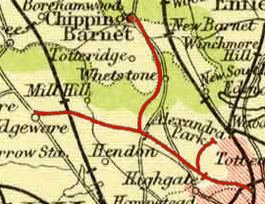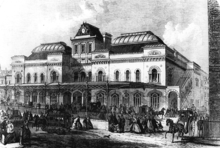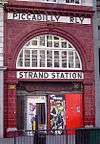Muswell Hill railway station
| Muswell Hill | |
|---|---|
 Muswell Hill station on a 1920 map | |
 Muswell Hill Location of Muswell Hill in Greater London | |
| Location | Muswell Hill |
| Local authority | Haringey |
| Number of platforms | 2 |
| Railway companies | |
| Original company | Muswell Hill Railway |
| Pre-grouping | Great Northern Railway |
| Post-grouping | London and North Eastern Railway |
| Key dates | |
| 1873 | Opened (MHR) |
| 1873 | Closed (MHR) |
| 1875 | Reopened (MHR) |
| 1951 | Closed (BR) |
| 1952 | Reopened (BR) |
| 1954 | Closed (passengers) (BR) |
| 1957 | Closed (goods) (BR) |
| Other information | |
| Lists of stations | |
| WGS84 | 51°35′27″N 0°08′26″W / 51.5909°N 0.1406°WCoordinates: 51°35′27″N 0°08′26″W / 51.5909°N 0.1406°W |
|
| |
Muswell Hill railway station was in Muswell Hill in North London, just north of the junction of Muswell Hill and Muswell Hill Place. Nothing remains of the station; Muswell Hill Primary School occupies its former site. In the 1930s plans were made to electrify the line and transfer the mainline service to London Underground's Northern line, but these were abandoned after the Second World War. The station closed in 1954.
History

The Muswell Hill Railway (MHR) opened the station on 24 May 1873 as Alexandra Park (Muswell Hill).[1] It was the intermediate station on the MHR's branch line from the Great Northern Railway's (GNR's) station at Highgate to Alexandra Palace. The line was constructed to bring passengers to Alexandra Palace and the branch line opened at the same time as the Palace. Following a fire at the Palace, the line was closed from 1 August 1873 to 1 May 1875 with the station being given its final name when reopened.[2] The other intermediate station on the line, Cranley Gardens, did not open until 1902. In 1911 the line was taken over by the GNR. After the 1921 Railways Act created the Big Four railway companies, the line was, from 1923, part of the London & North Eastern Railway (LNER).
In 1935 London Transport planned, as part of its "Northern Heights plan", to take over the line from LNER together with the LNER's routes from Finsbury Park to Edgware and High Barnet. The line was to be modernised to use electric trains and amalgamated with the Northern line. At Finsbury Park the line was to be connected to the Northern line's Northern City branch so that services from Muswell Hill would have continued to Moorgate.[3]
Works to modernise the track began in the late 1930s and were well advanced when they were interrupted by the Second World War. Works were completed from Highgate to High Barnet and Mill Hill East and that section was incorporated into the Northern line. Works on the tracks between Finsbury Park and Alexandra Palace were halted and the LNER continued to operate the line. In 1942, LNER, were reduced to rush hour only operations because of wartime economies.[4]
After the war, no work was carried out as maintenance works and reconstruction of war damage on the existing network had the greatest call on LPTB funds. Funds for new works were severely limited and priority was given to the completion of the western and eastern extensions of the Central line to West Ruislip, Epping and Hainault.[5] Despite being shown as under construction on underground maps as late as 1950,[n 1] work never restarted on the unimplemented parts of the Northern Heights plan.[10] British Railways (the successor to the LNER) closed the line temporarily from 29 October 1951 until 7 January 1952,[11] before ending passenger services between Finsbury Park and Alexandra Palace permanently on 3 July 1954.[12]
The line continued to be used for goods services until 18 May 1957 when it was closed completely. The track was removed and the platforms and station buildings were demolished. The trackbed between Muswell Hill and Finsbury Park is now the Parkland Walk.[13]
See also
Notes and references
Notes
- ↑ Shown as "under construction", the Northern Heights extensions appeared for the first time on Underground poster maps in 1937 and pocket maps in 1938.[6][7] After the opening of the tube platforms at Highgate and the extensions to High Barnet and Mill Hill East, the uncompleted remainder of the works were removed from the map between 1943 and 1945.[7] The Mill Hill East to Edgware and Edgware to Bushey Heath sections appeared on the map again from 1946 to 1949 and the Finsbury Park to Alexandra Palace section appeared from 1946 to 1950.[8][9]
References
- ↑ Horne & Bayman 1990, p. 41.
- ↑ Butt 1995, pp. 15 & 166.
- ↑ Horne 2009, p. 41.
- ↑ Day & Reed 2010, p. 140.
- ↑ Bownes, Green & Mullins 2012, p. 173.
- ↑ Beard 2002, pp. 56–57.
- 1 2 "London Transport Underground Maps 1938–1945". Archived from the original on 24 September 2015. Retrieved 1 April 2018.
- ↑ "London Transport Underground Maps 1946–1947". Archived from the original on 24 September 2015. Retrieved 1 April 2018.
- ↑ "London Transport Underground Maps 1948–1956". Archived from the original on 24 September 2015. Retrieved 1 April 2018.
- ↑ Day & Reed 2010, p. 152.
- ↑ Butt 1995, p. 70.
- ↑ Horne & Bayman 1990, p. 61.
- ↑ "Parkland Walk". London Borough of Islington. Retrieved 5 November 2017.
Bibliography
- Beard, Tony (2002). By Tube Beyond Edgware. Capital Transport. ISBN 978-1-85414-246-7.
- Bownes, David; Green, Oliver; Mullins, Sam (2012). Underground: How the Tube Shaped London. Allen Lane. ISBN 978-1-846-14462-2.
- Butt, R.V.J. (1995). The Directory of Railway Stations. Yeovil: Patrick Stephens Ltd. ISBN 1-85260-508-1. R508.
- Day, John R; Reed, John (2010) [1963]. The Story of London's Underground (11th ed.). Capital Transport. ISBN 978-1-85414-341-9.
- Horne, Mike; Bayman, Bob (1990). The First Tube: The Story of the Northern Line. Harrow Weald: Capital Transport. ISBN 1-85414-128-7.
- Horne, Mike (2009) [1990]. The Northern Line: An Illustrated History (3rd ed.). Capital Transport. ISBN 978-1-85414-326-6.
External links
- London's Transport Photographic Archive Muswell Hill station in 1935.
- Muswell Hill station on Subterranea Britannica
| Preceding station | Disused railways | Following station | ||
|---|---|---|---|---|
| Alexandra Palace Line and station closed |
British Railways (Eastern Region) Edgware, Highgate and London Railway |
Cranley Gardens Line and station closed | ||
| Abandoned Northern Heights Extension | ||||
| Preceding station | Following station | |||
Terminus | Northern line | towards Moorgate |
||

